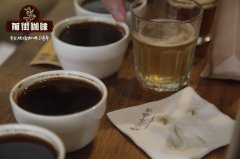The hometown of Coffee: an introduction to the Cultural treatment of planting in Ethiopia

Professional coffee knowledge exchange more coffee bean information please follow the coffee workshop (Wechat official account cafe_style)
Ethiopia can be said to be the most special coffee producer among so many coffee producing areas in the world. Here, people have discovered the existence of coffee; here, there are countless coffee lovers fascinated by the place-Yegashifi and Sidamo.
[coffee culture of Ethiopia]
Ethiopia is currently the largest coffee producer in Africa, but only 60% of the beans are exported and the rest are used in various forms of ceremony. for example, at weddings, coffee beans are mixed with coffee syrup, coffee and honey, and various herbs to ward off bad luck.
In Ethiopia, coffee has become a part of people's lives. For local people, coffee is not only a drink, but also a belief. There is a local ceremony known as the "coffee ceremony", which involves the whole process of stir-frying coffee beans, cooking coffee powder, brewing coffee and drinking coffee. This ceremony is a bit like the Japanese tea ceremony, in which there is a kind of spiritual consciousness. The purpose of the ceremony is to come to the conclusion that it can be used for a marriage proposal or to mediate family conflicts. The whole coffee ceremony was very long, about 1.5 hours on average. The ceremony begins with roasted coffee beans, and then the well-dressed women put the roasted coffee beans into the pot, so that everyone can smell the coffee beans, and then slowly make coffee.
The first cup of coffee is called Abol, which is the most important and worst cup to drink. If one of the parties must bravely drink the cup and state his point of view when resolving the conflict, the second cup is called Tona, which is boiled again with water, and the taste is still strong. If one party accepts his own point of view, he will drink it up, and if the other party does not drink it, there will be no third cup; the third cup is called Baraka, when the matter is settled and the conclusion is satisfactory, it symbolizes joy, and often the younger generation will be invited to drink this drink.
[the way Essex coffee is named]
Most of the coffee produced in Ethiopia is named after processing plants or cooperatives. This is because coffee farmers plant their own coffee trees near their living areas, harvest them during the harvest season, and then send them to nearby treatment plants built on water for unified treatment (or purchased by middlemen). In addition to a small number of plantations that have the strength to grow, pick and handle raw coffee beans independently, many coffee beans from different regions and varieties will be centrally processed by the processing plant and then sent to the auction house for official evaluation and grading.
This is also one of the reasons why the same batch of coffee beans are mixed with multiple coffee varieties, and even the flavor of different batches of coffee beans produced by the same treatment plant will be significantly different.
Ethiopian coffee is harvested once a year. The beautiful white coffee flowers bloom from March to April, and then the fruit begins to grow. From September to December, the red coffee fruit is ripe for picking. The new season of coffee begins to be exported from November to December.
Currently, about 25% of the Ethiopian population depends directly or indirectly on coffee production for a living. The majority of farmers use traditional planting methods. Artificial care of coffee trees, the use of organic fertilizers, do not use harmful pesticides and herbicides, etc. Therefore, most of the coffee produced in Ethiopia is organic coffee.
[Ethiopian Coffee cultivation]
Due to different planting methods, it can be divided into three types: forest-semi-forest coffee (Forest or semi-forest coffee), courtyard coffee (Gardencoffee) and plantation coffee (Plantation coffee). 60% of the coffee belongs to forest-semi-forest coffee. In such a wild coffee forest, pesticides are not used at all, but biological methods are used to control pests.
35% of the coffee is courtyard coffee. In this kind of coffee garden, the planting is three-dimensional. Coffee is located in the lower layer and gets a suitable growth environment in the shade of other crops. Fertilizers are mainly fallen leaves, withered grass and animal manure.
5% of the coffee belongs to plantation coffee. This is a modern way of growing. Coffee is also grown in a forest, but new varieties are used and planted in rows with other shade trees.
[Ethiopian Coffee varieties]
Nearly 2000 coffee varieties have been recorded in Ethiopia, including 1927 native varieties and 128 imported varieties. So just by looking at the appearance, Esther's coffee variety is "Grand View Garden", which has everything, long, short, thin, fat.
Long particles are found in all coffee growing areas in Ethiopia. From the actual proportion seen, there are more long particles in the western Jimma, including Limmu and Kaffa, and less in sidama (Sidamo) or yirgacheffe (Yega Sheffield).
Small grain species, the appearance is relatively round, the bean body is very small, mostly between 14-15 orders, this variety should be the most familiar to us, in Sidamo and Yegashiri can often see their figure, compared with other regions, sidama and yigracheffe and the surrounding arsi,guji have more native varieties of these small particles.
[Ethiopian Coffee handling]
There are two main treatments in Ethiopia, namely, sun treatment and water washing treatment.
Sun treatment
This is the oldest and most primitive treatment of coffee beans. The harvested coffee cherries are placed on the terrace, and some are even directly exposed to the sun on the side of the road (about 27-30 days). The moisture is dried from 60% to only about 12%.
Features: low acidity, obvious sweetness, high alcohol thickness, rich layers, slightly lower cleanliness.
Washing treatment method
Washing treatment is to remove peel, pulp, pectin, etc., then fermented in the flume, and then dried; washing process: selecting → to remove pulp, → fermentation, → washing, → drying, → shelling → selection and classification.
The peel, pulp and mucous membrane are removed by washing and fermentation. farms that use the washing method must build washing ponds and be able to introduce an endless supply of live water. During the treatment, the fermented beans are put into the pool and passed back and forth, using the friction of the beans and the power of running water to wash the coffee beans until smooth and clean.
After washing, the coffee beans are still wrapped in the pericarp with a moisture content of 50%. They must be dried to reduce the moisture content to 12%, otherwise they will continue to ferment and become moldy and rotten.
Features: obvious acidity, good cleanliness, medium alcohol thickness, high stability.
[Ethiopian coffee producing area]
There are nine major coffee producing areas in Ethiopia: Sidamo, Yegashefi, Hara, Gemma, Lim, Iruba, Gimbi (Lekanti), Tibby, and Bebeca. Among the nine major coffee producing areas in Ethiopia, the most famous are Yegashefi, Sidamo and Harald, and there are also small producing areas in the large producing areas, such as Cochel and Arica in the Yegashafi producing area, and then there are smaller village producing areas. The coffee plantation in Ethiopia is not obvious, so it is generally divided into large producing areas, small producing areas, village producing areas and washing plants.
Yejia Xuefei: 1800 Murray 2000 meters above sea level | Pastoral Coffee system |
Yega Xuefei is affiliated to the Sidamo region. Because of its unique flavor, rich and complex fruit aroma, it became popular almost overnight, causing Ethiopian coffee farmers to take pride in the flavor of their own coffee. So it was separated out separately. It has been a wetland since ancient times. The ancient saying "Yirga" means "settle down" and "Cheffe" means "wetland". In addition to the small town of Yega Xuefei, it also includes three by-product areas around Wenago, Kochere, Gelena and Abaya. Therefore, YirgacheffeA, Wenago A, Kochere An and Gelena/AbayaA will be more expensive than B of the same name in the new Yega Sheffield rating system.
Related recommendation: Ethiopia YCFCU cooperative several characteristic varieties recommendation introduction flavor description
Important Notice :
前街咖啡 FrontStreet Coffee has moved to new addredd:
FrontStreet Coffee Address: 315,Donghua East Road,GuangZhou
Tel:020 38364473
- Prev

Should cold coffee go with it? What do you have for cold coffee?
Professional coffee knowledge exchange more coffee bean information Please pay attention to the coffee workshop (Wechat official account cafe_style) Coffee flavor varies according to the treatment and baking depth, and how to match with the dim sum? (photo Source: happiness Culture) the effect of coffee bean treatment on flavor traditionally, raw beans are picked and processed, which can be divided into sun exposure according to local climate conditions.
- Next

The present situation of Coffee in Yunnan where is the species of coffee in Yunnan?
Professional coffee knowledge exchange more coffee bean information please follow the coffee workshop (Wechat official account cafe_style) Pu'er City, Yunnan Province, Menglian County on the Sino-Myanmar border. Shen Xuejing was a little frustrated because the owner of the hill where she was now told her that the batch of coffee beans she had come to taste after a five-hour drive from Pu'er, 230 kilometers away, was gone. Shen Xuejing is from
Related
- How did the Salvadoran coffee industry develop in Central America?
- What exactly does the golden cup extraction of coffee mean?
- The Origin of Coffee flower
- [2023 Starbucks World Earth Day] there are more meaningful things besides free Starbucks coffee!
- What kind of coffee is there in Spain? 9 Flavors of Spanish Coffee
- Aromatic African coffee| Kenya's coffee culture and historical production area
- Liberica Coffee Bean knowledge: the characteristics of Liberian Coffee beans of the three original species of Coffee beans
- The origin and formula of Spanish latte introduces the taste characteristics of Bombon coffee in Valencia, Spain.
- How to adjust the solution of over-extracted coffee
- What is the tasting period of coffee beans? What is the period of coffee and beans? How should coffee wake up and raise beans?

